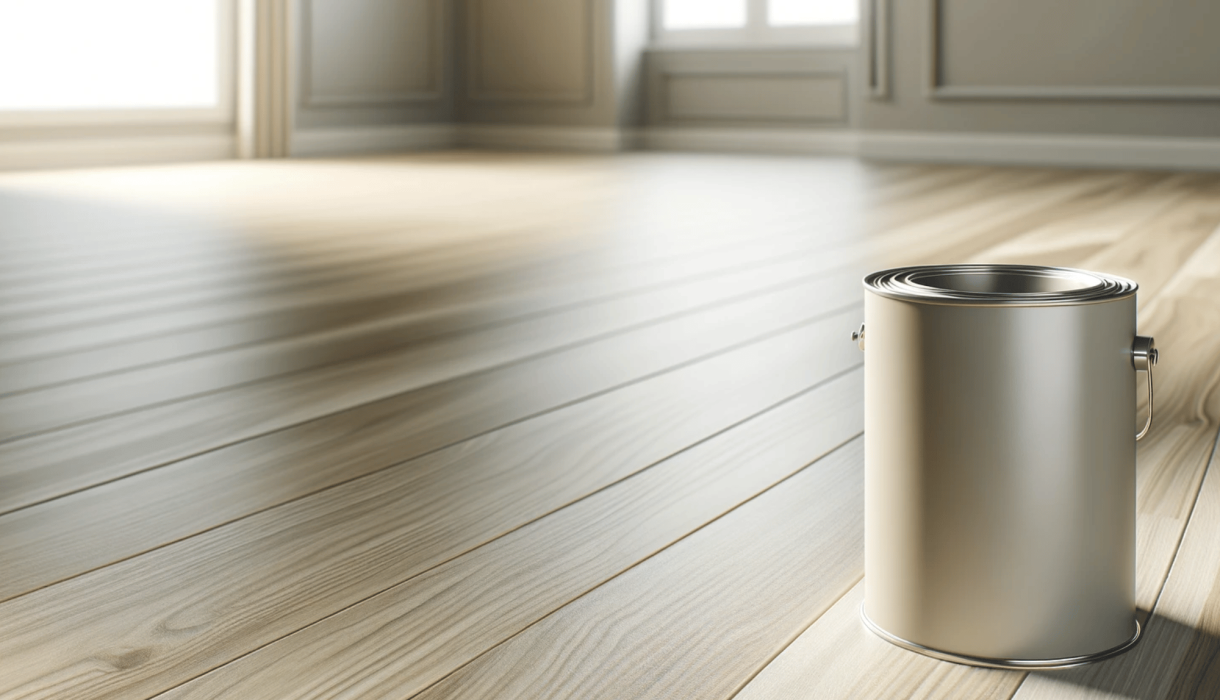Vinyl flooring looking tired but you’re not ready for a full replacement? Many homeowners wonder if a fresh coat of paint could breathe new life into their worn vinyl floors. The question seems simple, but the answer requires some nuance. While technically possible, painting vinyl flooring comes with significant considerations that might affect your decision.
At Abernethy Bespoke Flooring, we’ve seen plenty of DIY flooring projects—both successes and disasters. This guide will walk you through everything you need to know about painting vinyl flooring, from preparation to finishing touches, so you can make an informed choice for your home.
Is Painting Vinyl Flooring Really Possible?
Yes, vinyl flooring can be painted—but that doesn’t mean it should be. Vinyl isn’t naturally designed to accept paint. Its smooth, often glossy surface actively resists paint adhesion, which means special preparation and products are necessary for any chance of success.
The lifespan of painted vinyl flooring typically reaches 1-3 years before showing significant wear, depending on foot traffic. High-traffic areas like hallways or kitchens will show wear paths much sooner, often within months.
Most professional flooring experts, including our team at Abernethy Bespoke Flooring, generally recommend replacement over painting for long-term satisfaction. However, we recognise that painting might make sense in certain situations:
- When working within tight budget constraints
- For rarely-used rooms or low-traffic areas
- As a temporary solution before planned renovation
- In rental properties where permanent changes aren’t permitted
- When the vinyl is structurally sound but simply outdated in appearance
Paint will never quite match the durability or appearance of factory-finished vinyl flooring. Even with perfect application, the texture and finish will differ from purpose-made products. Setting realistic expectations from the start helps prevent disappointment with the results.
Essential Preparation: Setting Yourself Up for Success
If you’ve decided to proceed with painting your vinyl flooring, thorough preparation becomes absolutely critical. This stage makes the difference between paint that peels within weeks and a finish that lasts years.
Getting Your Floor Properly Clean
Begin by removing all furniture and thoroughly cleaning the entire floor. Vinyl’s smooth surface can trap oils, dirt, and cleaning residues that prevent paint adhesion.
Start with a thorough sweep and vacuum to remove loose debris. Follow with a deep clean using a vinyl-specific cleaner or mild detergent mixed with warm water. Kitchens require extra attention—use a degreaser to remove cooking oils that might have settled on the floor over time.
After cleaning, rinse the entire surface with clean water to remove all cleaning solution residues. Allow the floor to dry completely for at least 24 hours. Any trapped moisture or cleaning residue practically guarantees paint failure, so patience during this step pays off significantly.
Creating a Surface That Paint Will Stick To
Vinyl’s slick surface needs to be lightly abraded to accept paint properly. Sand the entire floor with fine-grit sandpaper (180-220 grit) to create a slightly textured surface. You’re not trying to remove material—just creating microscopic scratches that give the primer something to grip.
Pay extra attention to high-gloss areas, as these need more scuffing to accept paint. Once sanding is complete, thoroughly vacuum and wipe the floor with a slightly damp cloth to remove all sanding dust. Again, allow the floor to dry completely before moving forward.
Some flooring professionals recommend cleaning with TSP (trisodium phosphate) after sanding for enhanced adhesion, but this requires careful handling and thorough rinsing to avoid issues.
Addressing Existing Damage
Painting won’t hide structural problems with your vinyl flooring. Before proceeding, assess your floor for:
- Tears or cuts in the vinyl
- Bubbles or air pockets
- Loose edges or seams
- Deep gouges or indentations
- Water damage or mould
Minor issues like small gouges can be addressed with vinyl floor patch before painting. Loose edges might be secured with vinyl adhesive. However, more significant problems signal that the floor might be past its useful life, making proper Floor Preparation and replacement a better investment than painting.
Choosing the Right Products for Lasting Results
The products you select dramatically impact your success when painting vinyl flooring. Using the wrong materials virtually guarantees disappointment.
Primers That Actually Work on Vinyl
The single most important product in your painting project is the primer. This creates the foundation that allows paint to bond with the vinyl surface. Look specifically for:
- Bonding primers designed for non-porous surfaces
- Primers that explicitly mention vinyl, plastic, or laminate surfaces
- Water-based products for easier application and cleanup
Apply primer with a high-quality synthetic bristle brush for edges and corners, and a medium-nap roller for larger areas. Keep the coat thin and even—thick primer application can lead to cracking. Allow the primer to dry completely according to manufacturer instructions before proceeding.
Floor-Specific Paints Only
Standard wall paint will quickly wear off when applied to floors. Instead, choose:
- Acrylic latex floor paint: Provides good flexibility and adhesion with moderate durability. Make sure the product specifically says “floor paint” on the label.
- Porch and floor enamel: Offers better durability than standard paint but requires longer curing time.
- Epoxy floor coating: The most durable option but also the most challenging to apply correctly. Two-part epoxy systems require precise mixing and application within specific timeframes.
Avoid standard wall paints, oil-based paints (which remain too flexible on vinyl), chalk paints, and generic multi-surface paints not specifically formulated for floors.
Protective Topcoats for Longevity
A quality clear topcoat significantly extends the life of painted vinyl flooring:
- Water-based polyurethane designed for floors (apply 2-3 coats)
- Floor-grade clear epoxy sealer
- Specially formulated floor wax products
The extra protection from a quality sealer can double the lifespan of your painted vinyl floor, making this step well worth the additional time and expense.
The Painting Process: Patience Pays Off
With proper preparation complete and the right products on hand, the actual painting process requires attention to detail and, above all, patience.
Start in the farthest corner from the exit and work in small sections (approximately 3×3 feet) to maintain a wet edge. Apply thin, even coats—multiple thin layers significantly outperform one thick coat in both appearance and durability.
Allow each coat to dry completely according to the manufacturer’s instructions. This typically means at least 6-8 hours between coats, though some products may require longer. Apply at least 2-3 coats for adequate coverage and durability.
When all paint coats have dried (usually 24-48 hours after the final coat), apply the protective topcoat using a new, clean roller to avoid contamination. Apply in the same pattern as the paint for a consistent finish, and apply 2-3 coats, allowing proper drying time between each.
The most common mistake DIYers make is rushing the process and not allowing proper drying and curing times. This includes:
- Waiting at least 24 hours before allowing light foot traffic
- Avoiding furniture replacement for 72 hours minimum
- Keeping pets off the floor for at least 3-4 days
- Waiting 14 days before placing rugs
- Allowing 30 days before wet cleaning
Rushing these timeframes is the quickest way to ruin your hard work and end up with peeling, scratched paint.
Living With Painted Vinyl Flooring
Even with perfect application, painted vinyl requires gentler treatment than factory-finished floors.
For regular cleaning, use a dust mop or vacuum with a soft brush attachment. When deeper cleaning is needed, use a barely damp mop with mild cleaners specifically designed for painted surfaces. Avoid harsh chemicals, ammonia, or abrasive cleaners that can damage the paint and protective coating.
Clean spills promptly to prevent staining and potential damage to the painted surface. Use protective felt pads under furniture to prevent scratches, and consider using area rugs in high-traffic zones to extend the life of your painted floor.
Keep leftover paint for inevitable touch-ups. High-traffic areas may need spot repairs long before the rest of the floor shows wear. For significant wear, light sanding and reapplication of paint and sealer in the affected area can extend the floor’s life, though colour matching can become challenging after the original paint has aged.
When to Skip Painting and Choose Replacement
While painting vinyl flooring can provide a temporary refresh, several situations make replacement the more sensible option:
- Structural issues: Tears, bubbles, or lifting edges indicate the vinyl is failing and should be replaced.
- High-traffic areas: Painted vinyl in busy areas like hallways, kitchens, or entryways will show wear paths quickly, making the effort of painting short-lived.
- Long-term value: If you plan to stay in your home for years to come, new flooring provides better long-term value despite higher upfront costs.
- Water-prone areas: Bathrooms, laundry rooms, and similar spaces benefit from properly installed waterproof flooring rather than painted solutions.
Modern Vinyl Flooring has evolved dramatically in recent years. Today’s products offer incredible durability with thick wear layers, remarkably realistic wood and stone appearances, excellent water and stain resistance, and simple maintenance requirements. Many options are designed for DIY-friendly installation, making them more accessible than you might expect.
For premium performance, professionally installed LVT Floor Fitting provides superior thickness and wear resistance, extremely realistic textures and designs, outstanding durability in high-traffic areas, and excellent sound absorption properties.
Homeowners seeking distinctive, high-end looks might consider specialty installations like Herringbone Flooring, which creates timeless elegance that painted floors simply cannot match.
Professional Assessment: The Smart First Step
Not sure whether to paint or replace your vinyl flooring? A professional assessment can save you time, money, and potential disappointment.
Our team at Abernethy Bespoke Flooring offers free consultations to evaluate your current flooring and discuss the most appropriate solutions for your specific situation. We’ll provide honest advice about whether painting makes sense for your floor or if replacement would offer better value.
For expert guidance tailored to your flooring needs, contact us at 07495 424721 or email michaelabernethy@live.co.uk to schedule your free consultation.
The bottom line? Yes, you can paint vinyl flooring—but knowing when you should is the real key to satisfaction with your floors.


